The Cambridge History of Japan, Vol. 1: Ancient Japan
Подождите немного. Документ загружается.

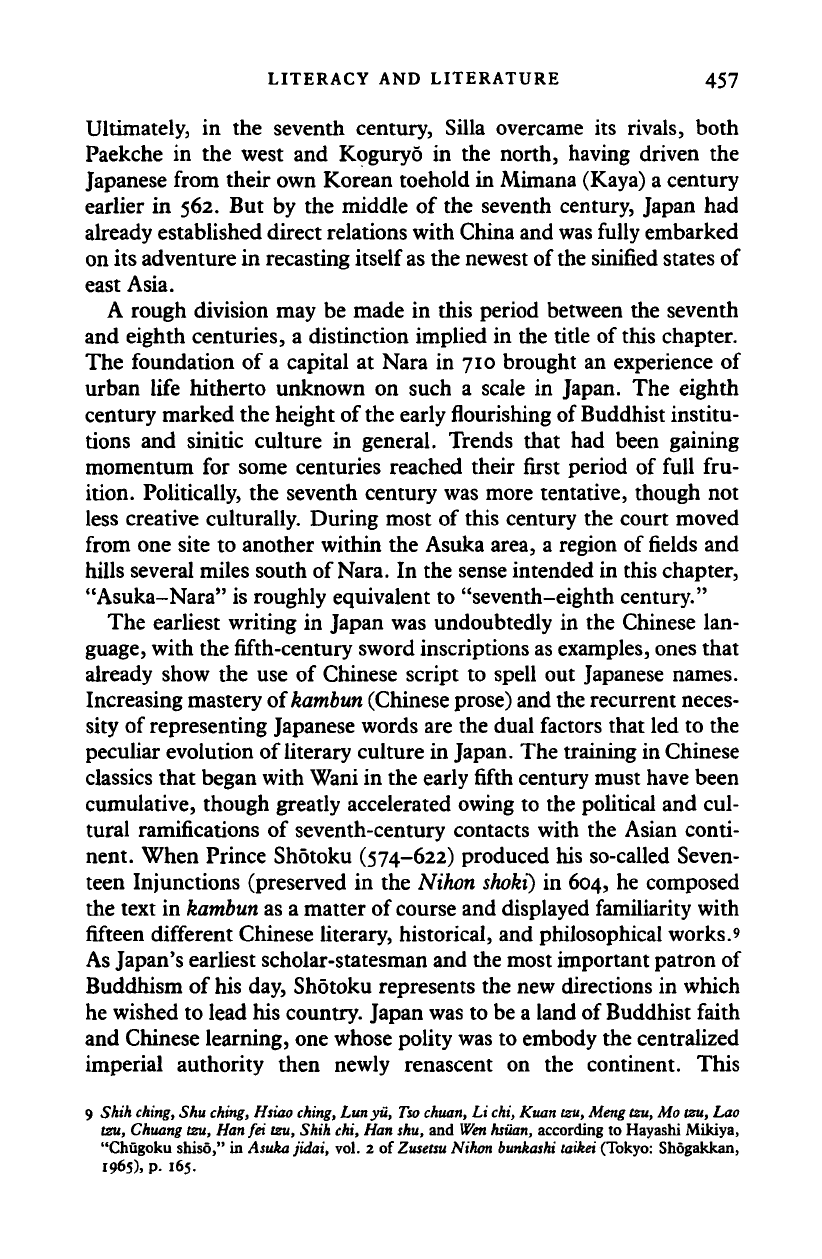
LITERACY AND LITERATURE 457
Ultimately, in the seventh century, Silla overcame its rivals, both
Paekche in the west and Koguryo in the north, having driven the
Japanese from their own Korean toehold in Mimana (Kaya) a century
earlier in 562. But by the middle of the seventh century, Japan had
already established direct relations with China and was fully embarked
on its adventure in recasting itself
as
the newest of the sinified states of
east Asia.
A rough division may be made in this period between the seventh
and eighth centuries, a distinction implied in the title of this chapter.
The foundation of a capital at Nara in 710 brought an experience of
urban life hitherto unknown on such a scale in Japan. The eighth
century marked the height of the early flourishing of Buddhist institu-
tions and sinitic culture in general. Trends that had been gaining
momentum for some centuries reached their first period of full fru-
ition. Politically, the seventh century was more tentative, though not
less creative culturally. During most of this century the court moved
from one site to another within the Asuka area, a region of fields and
hills several miles south of
Nara.
In the sense intended in this chapter,
"Asuka-Nara" is roughly equivalent to "seventh-eighth century."
The earliest writing in Japan was undoubtedly in the Chinese lan-
guage, with the fifth-century sword inscriptions as examples, ones that
already show the use of Chinese script to spell out Japanese names.
Increasing mastery oikambun (Chinese prose) and the recurrent neces-
sity of representing Japanese words are the dual factors that led to the
peculiar evolution of literary culture in Japan. The training in Chinese
classics that began with Wani in the early fifth century must have been
cumulative, though greatly accelerated owing to the political and cul-
tural ramifications of seventh-century contacts with the Asian conti-
nent. When Prince Shotoku (574-622) produced his so-called Seven-
teen Injunctions (preserved in the Nihon
shoki)
in 604, he composed
the text in
kambun
as a matter of course and displayed familiarity with
fifteen different Chinese literary, historical, and philosophical works.9
As Japan's earliest scholar-statesman and the most important patron of
Buddhism of his day, Shotoku represents the new directions in which
he wished to lead his country. Japan was to be a land of Buddhist faith
and Chinese learning, one whose polity was to embody the centralized
imperial authority then newly renascent on the continent. This
9 Shih
ching,
Shu
ching,
Hsiao
ching,
Lunyu,
Tso
chuan,
Li chi, Kuan tzu, Meng tzu, Mo tzu, Lao
tzu,
Chuang tzu,
Han
fei tzu, Shih chi, Han shu, and
Wen
hsuan,
according to Hayashi Mikiya,
"Chugoku shiso," in Asuka jidai, vol. 2 oiZusetsu Nihon
bunkashi
taikei (Tokyo: Shogakkan,
1965).
P- 165.
Cambridge Histories Online © Cambridge University Press, 2008
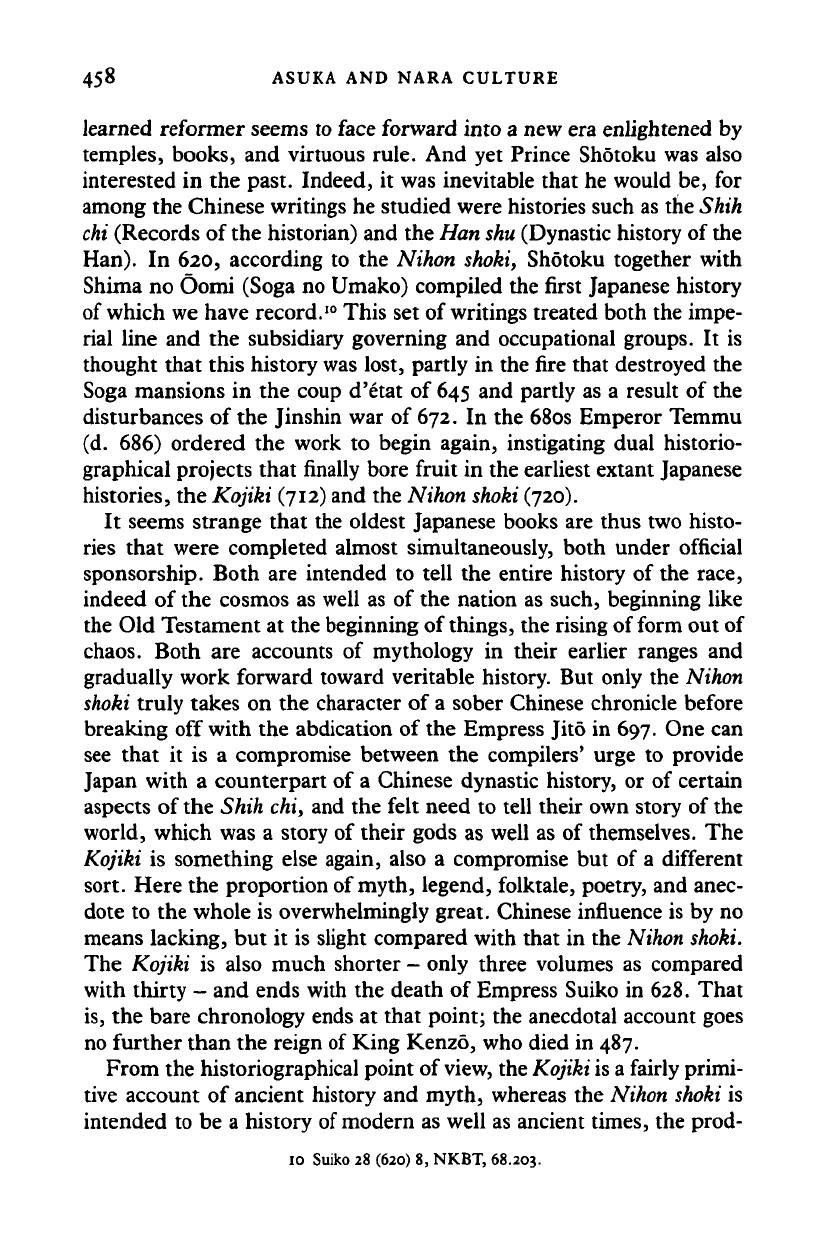
458 ASUKA AND NARA CULTURE
learned reformer seems to face forward into a new era enlightened by
temples, books, and virtuous rule. And yet Prince Shotoku was also
interested in the past. Indeed, it was inevitable that he would be, for
among the Chinese writings he studied were histories such as the Shih
chi
(Records of the historian) and the Han
shu
(Dynastic history of the
Han).
In 620, according to the Nihon shoki, Shotoku together with
Shima no Oomi (Soga no Umako) compiled the first Japanese history
of which we have record.
10
This set of writings treated both the impe-
rial line and the subsidiary governing and occupational groups. It is
thought that this history was lost, partly in the fire that destroyed the
Soga mansions in the coup d'etat of 645 and partly as a result of the
disturbances of the Jinshin war of
672.
In the 680s Emperor Temmu
(d. 686) ordered the work to begin again, instigating dual historio-
graphical projects that finally bore fruit in the earliest extant Japanese
histories, the Kojiki (712) and the Nihon
shoki
(720).
It seems strange that the oldest Japanese books are thus two histo-
ries that were completed almost simultaneously, both under official
sponsorship. Both are intended to tell the entire history of the race,
indeed of the cosmos as well as of the nation as such, beginning like
the Old Testament at the beginning of
things,
the rising of form out of
chaos.
Both are accounts of mythology in their earlier ranges and
gradually work forward toward veritable history. But only the Nihon
shoki
truly takes on the character of a sober Chinese chronicle before
breaking off with the abdication of the Empress Jito in 697. One can
see that it is a compromise between the compilers' urge to provide
Japan with a counterpart of a Chinese dynastic history, or of certain
aspects of the Shih chi, and the felt need to tell their own story of the
world, which was a story of their gods as well as of themselves. The
Kojiki is something else again, also a compromise but of a different
sort. Here the proportion of myth, legend, folktale, poetry, and anec-
dote to the whole is overwhelmingly great. Chinese influence is by no
means lacking, but it is slight compared with that in the Nihon shoki.
The Kojiki is also much shorter - only three volumes as compared
with thirty - and ends with the death of Empress Suiko in 628. That
is,
the bare chronology ends at that point; the anecdotal account goes
no further than the reign of King Kenzo, who died in 487.
From the historiographical point of
view,
the Kojiki is a fairly primi-
tive account of ancient history and myth, whereas the Nihon
shoki
is
intended to be a history of modern as well as ancient times, the prod-
10 Suiko 28 (620) 8, NKBT, 68.203.
Cambridge Histories Online © Cambridge University Press, 2008
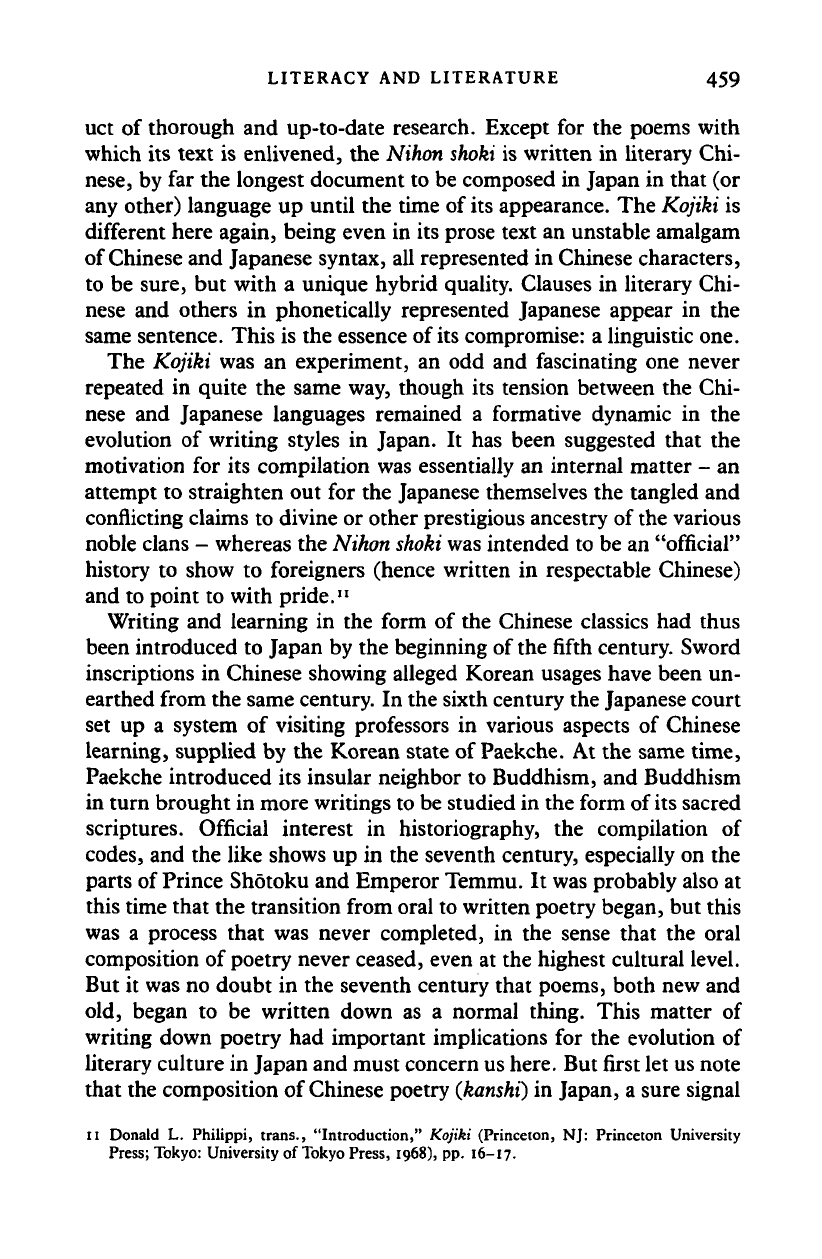
LITERACY AND LITERATURE 459
uct of thorough and up-to-date research. Except for the poems with
which its text is enlivened, the Nihon
shoki
is written in literary Chi-
nese,
by far the longest document to be composed in Japan in that (or
any other) language up until the time of its appearance. The Kojiki is
different here again, being even in its prose text an unstable amalgam
of Chinese and Japanese syntax, all represented in Chinese characters,
to be sure, but with a unique hybrid quality. Clauses in literary Chi-
nese and others in phonetically represented Japanese appear in the
same sentence. This is the essence of
its
compromise: a linguistic one.
The Kojiki was an experiment, an odd and fascinating one never
repeated in quite the same way, though its tension between the Chi-
nese and Japanese languages remained a formative dynamic in the
evolution of writing styles in Japan. It has been suggested that the
motivation for its compilation was essentially an internal matter - an
attempt to straighten out for the Japanese themselves the tangled and
conflicting claims to divine or other prestigious ancestry of the various
noble clans - whereas the Nihon
shoki
was intended to be an "official"
history to show to foreigners (hence written in respectable Chinese)
and to point to with pride.
11
Writing and learning in the form of the Chinese classics had thus
been introduced to Japan by the beginning of the fifth century. Sword
inscriptions in Chinese showing alleged Korean usages have been un-
earthed from the same century. In the sixth century the Japanese court
set up a system of visiting professors in various aspects of Chinese
learning, supplied by the Korean state of
Paekche.
At the same time,
Paekche introduced its insular neighbor to Buddhism, and Buddhism
in turn brought in more writings to be studied in the form of
its
sacred
scriptures. Official interest in historiography, the compilation of
codes,
and the like shows up in the seventh century, especially on the
parts of Prince Shotoku and Emperor Temmu. It was probably also at
this time that the transition from oral to written poetry began, but this
was a process that was never completed, in the sense that the oral
composition of poetry never ceased, even at the highest cultural level.
But it was no doubt in the seventh century that poems, both new and
old, began to be written down as a normal thing. This matter of
writing down poetry had important implications for the evolution of
literary culture in Japan and must concern us here. But first let us note
that the composition of Chinese poetry
(kanshi)
in Japan, a sure signal
ii Donald L. Philippi, trans., "Introduction," Kojiki (Princeton, NJ: Princeton University
Press;
Tokyo: University of Tokyo Press, 1968), pp. 16-17.
Cambridge Histories Online © Cambridge University Press, 2008
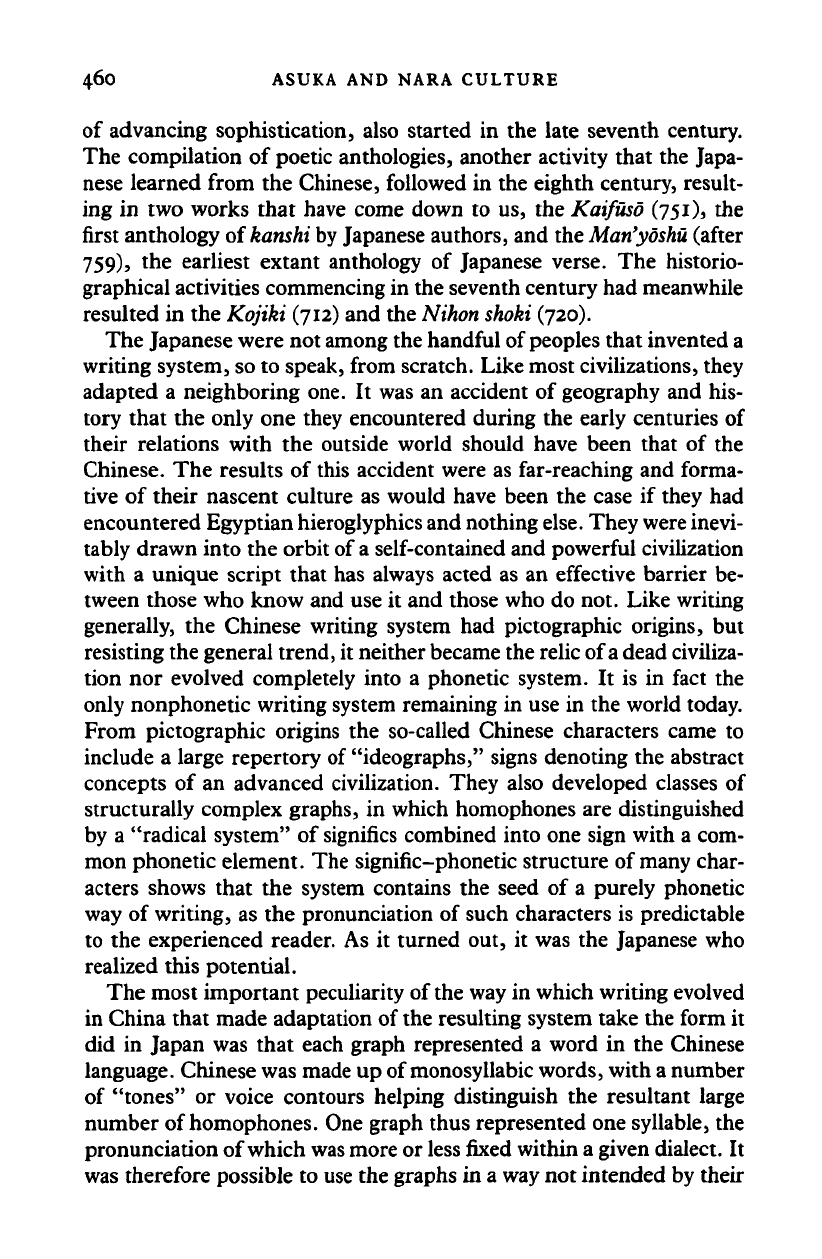
460 ASUKA AND NARA CULTURE
of advancing sophistication, also started in the late seventh century.
The compilation of poetic anthologies, another activity that the Japa-
nese learned from the Chinese, followed in the eighth century, result-
ing in two works that have come down to us, the Kaifuso (751), the
first anthology of
kanshi
by Japanese authors, and the
Man'yoshu
(after
759),
the earliest extant anthology of Japanese verse. The historio-
graphical activities commencing in the seventh century had meanwhile
resulted in the Kojiki (712) and the Nihon
shoki
(720).
The Japanese were not among the handful of peoples that invented a
writing system, so to speak, from scratch. Like most civilizations, they
adapted a neighboring one. It was an accident of geography and his-
tory that the only one they encountered during the early centuries of
their relations with the outside world should have been that of the
Chinese. The results of this accident were as far-reaching and forma-
tive of their nascent culture as would have been the case if they had
encountered Egyptian hieroglyphics and nothing
else.
They
were
inevi-
tably drawn into the orbit of
a
self-contained and powerful civilization
with a unique script that has always acted as an effective barrier be-
tween those who know and use it and those who do not. Like writing
generally, the Chinese writing system had pictographic origins, but
resisting the general trend, it neither became the relic of
a
dead civiliza-
tion nor evolved completely into a phonetic system. It is in fact the
only nonphonetic writing system remaining in use in the world today.
From pictographic origins the so-called Chinese characters came to
include a large repertory of "ideographs," signs denoting the abstract
concepts of an advanced civilization. They also developed classes of
structurally complex graphs, in which homophones are distinguished
by a "radical system" of signifies combined into one sign with a com-
mon phonetic element. The signific-phonetic structure of many char-
acters shows that the system contains the seed of a purely phonetic
way of writing, as the pronunciation of such characters is predictable
to the experienced reader. As it turned out, it was the Japanese who
realized this potential.
The most important peculiarity of
the
way in which writing evolved
in China that made adaptation of the resulting system take the form it
did in Japan was that each graph represented a word in the Chinese
language. Chinese was made up of monosyllabic words, with a number
of "tones" or voice contours helping distinguish the resultant large
number of homophones. One graph thus represented one syllable, the
pronunciation of which
was
more or less fixed within a given dialect. It
was therefore possible to use the graphs in a way not intended by their
Cambridge Histories Online © Cambridge University Press, 2008
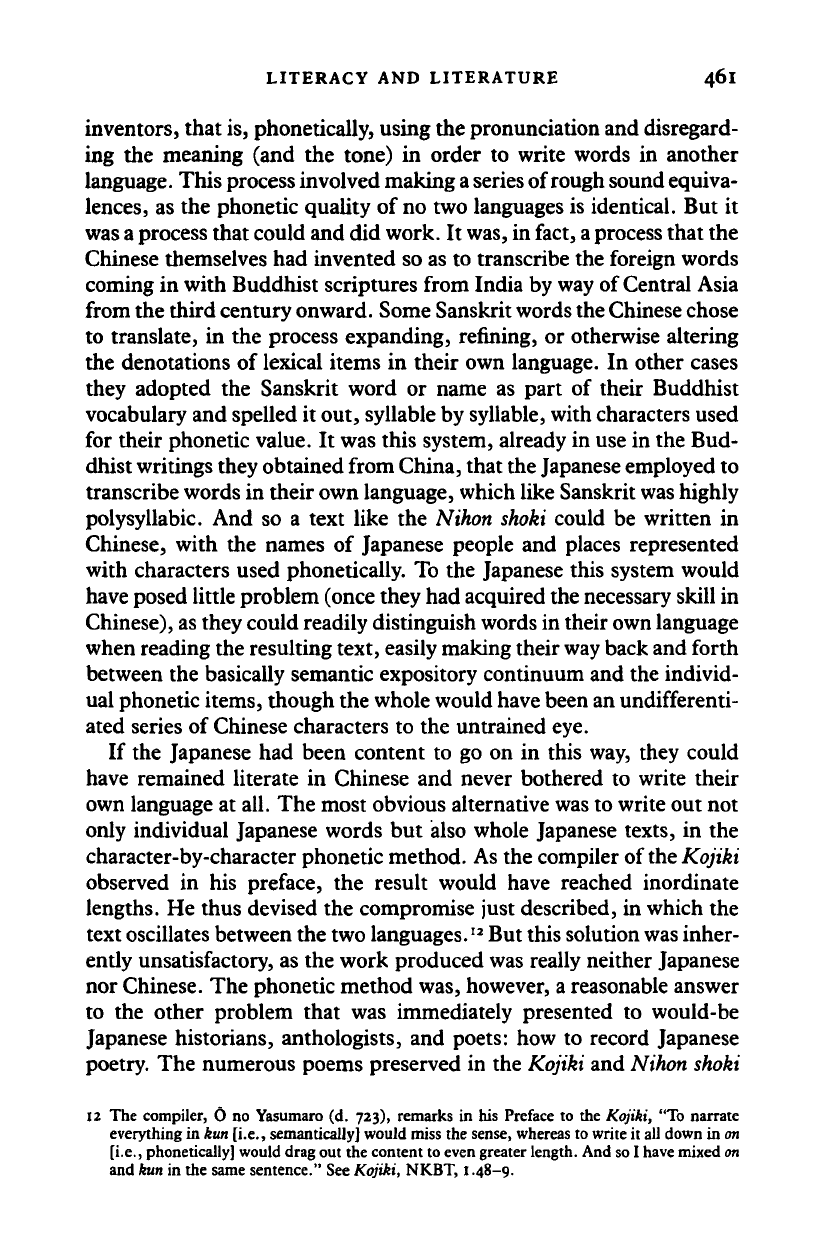
LITERACY AND LITERATURE 461
inventors, that
is,
phonetically, using the pronunciation and disregard-
ing the meaning (and the tone) in order to write words in another
language. This process involved making
a series
of rough sound equiva-
lences, as the phonetic quality of no two languages is identical. But it
was a
process that could and did work. It
was,
in fact,
a
process that the
Chinese themselves had invented so as to transcribe the foreign words
coming in with Buddhist scriptures from India by way of Central Asia
from the third century onward. Some Sanskrit words the Chinese chose
to translate, in the process expanding, refining, or otherwise altering
the denotations of lexical items in their own language. In other cases
they adopted the Sanskrit word or name as part of their Buddhist
vocabulary and spelled it out, syllable by syllable, with characters used
for their phonetic value. It was this system, already in use in the Bud-
dhist writings they obtained from China, that the Japanese employed to
transcribe words in their own language, which like Sanskrit
was
highly
polysyllabic. And so a text like the Nihon
shoki
could be written in
Chinese, with the names of Japanese people and places represented
with characters used phonetically. To the Japanese this system would
have posed little problem (once they had acquired the necessary skill in
Chinese), as they could readily distinguish words in their own language
when reading the resulting text, easily making their
way
back and forth
between the basically semantic expository continuum and the individ-
ual phonetic items, though the whole would have been an undifferenti-
ated series of Chinese characters to the untrained eye.
If the Japanese had been content to go on in this way, they could
have remained literate in Chinese and never bothered to write their
own language at all. The most obvious alternative was to write out not
only individual Japanese words but also whole Japanese texts, in the
character-by-character phonetic method. As the compiler of the Kojiki
observed in his preface, the result would have reached inordinate
lengths. He thus devised the compromise just described, in which the
text oscillates between the two languages.
12
But this solution
was
inher-
ently unsatisfactory, as the work produced was really neither Japanese
nor Chinese. The phonetic method was, however, a reasonable answer
to the other problem that was immediately presented to would-be
Japanese historians, anthologists, and poets: how to record Japanese
poetry. The numerous poems preserved in the Kojiki and Nihon
shoki
12 The compiler, O no Yasumaro (d. 723), remarks in his Preface to the Kojiki, "To narrate
everything in
kun
[i.e., semantically] would miss the sense, whereas to write it all down in
on
[i.e.,
phonetically] would drag out the content to even greater length. And so I have mixed
on
and kun in the same sentence." See Kojiki, NKBT,
1.48-9.
Cambridge Histories Online © Cambridge University Press, 2008
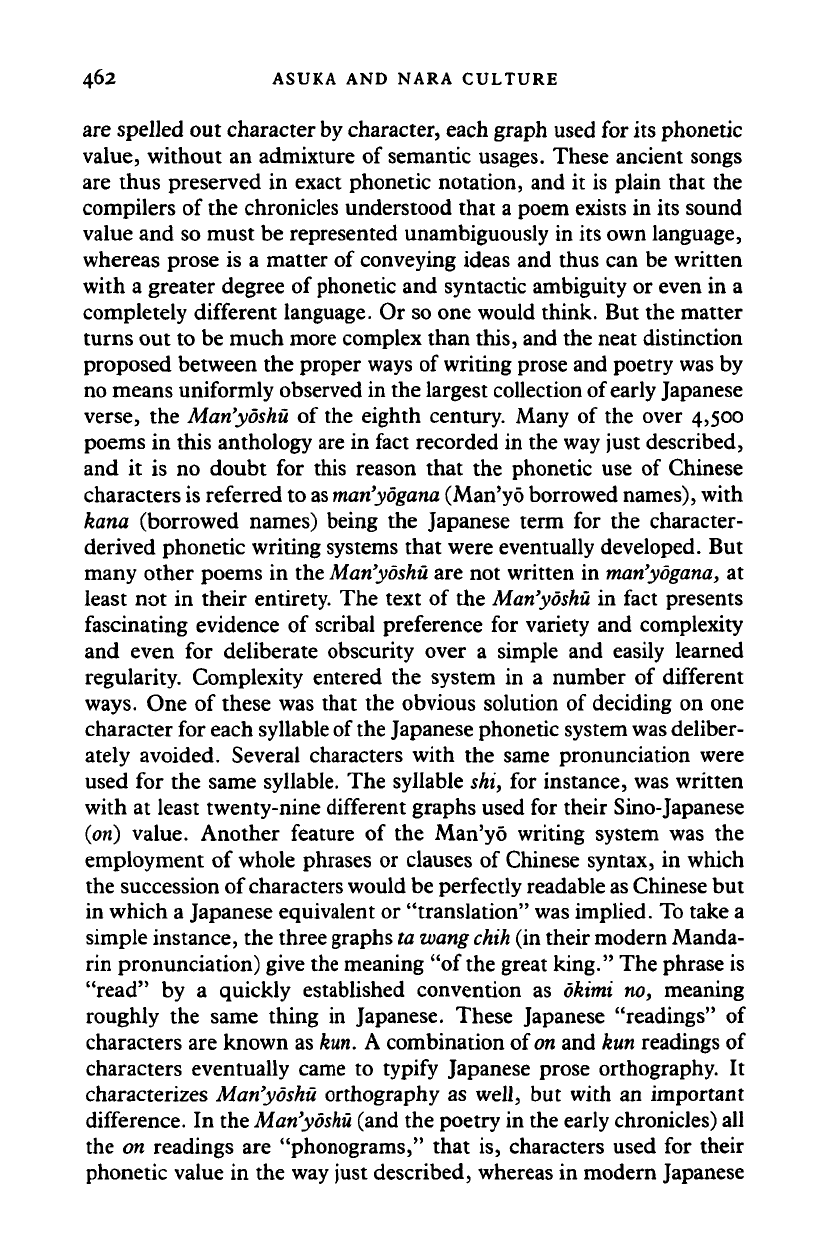
462 ASUKA AND NARA CULTURE
are spelled out character by character, each graph used for its phonetic
value, without an admixture of semantic usages. These ancient songs
are thus preserved in exact phonetic notation, and it is plain that the
compilers of the chronicles understood that a poem exists in its sound
value and so must be represented unambiguously in its own language,
whereas prose is a matter of conveying ideas and thus can be written
with a greater degree of phonetic and syntactic ambiguity or even in a
completely different language. Or so one would think. But the matter
turns out to be much more complex than this, and the neat distinction
proposed between the proper ways of writing prose and poetry was by
no means uniformly observed in the largest collection of early Japanese
verse, the Man'yoshu of the eighth century. Many of the over 4,500
poems in this anthology are in fact recorded in the way just described,
and it is no doubt for this reason that the phonetic use of Chinese
characters is referred to
as man'yogana
(Man'yo borrowed names), with
kana (borrowed names) being the Japanese term for the character-
derived phonetic writing systems that were eventually developed. But
many other poems in the
Man'yoshu
are not written in
man'yogana,
at
least not in their entirety. The text of the
Man'yoshu
in fact presents
fascinating evidence of scribal preference for variety and complexity
and even for deliberate obscurity over a simple and easily learned
regularity. Complexity entered the system in a number of different
ways.
One of these was that the obvious solution of deciding on one
character for each syllable of
the
Japanese phonetic system was deliber-
ately avoided. Several characters with the same pronunciation were
used for the same syllable. The syllable shi, for instance, was written
with at least twenty-nine different graphs used for their Sino-Japanese
(on) value. Another feature of the Man'yo writing system was the
employment of whole phrases or clauses of Chinese syntax, in which
the succession of characters would be perfectly readable as Chinese but
in which a Japanese equivalent or "translation" was implied. To take a
simple instance, the three graphs
ta wang chih
(in their modern Manda-
rin pronunciation) give the meaning "of the great king." The phrase is
"read" by a quickly established convention as okimi no, meaning
roughly the same thing in Japanese. These Japanese "readings" of
characters are known as
kun.
A combination of
on
and kun readings of
characters eventually came to typify Japanese prose orthography. It
characterizes Man'yoshu orthography as well, but with an important
difference. In the
Man'yoshu
(and the poetry in the early chronicles) all
the on readings are "phonograms," that is, characters used for their
phonetic value in the way just described, whereas in modern Japanese
Cambridge Histories Online © Cambridge University Press, 2008
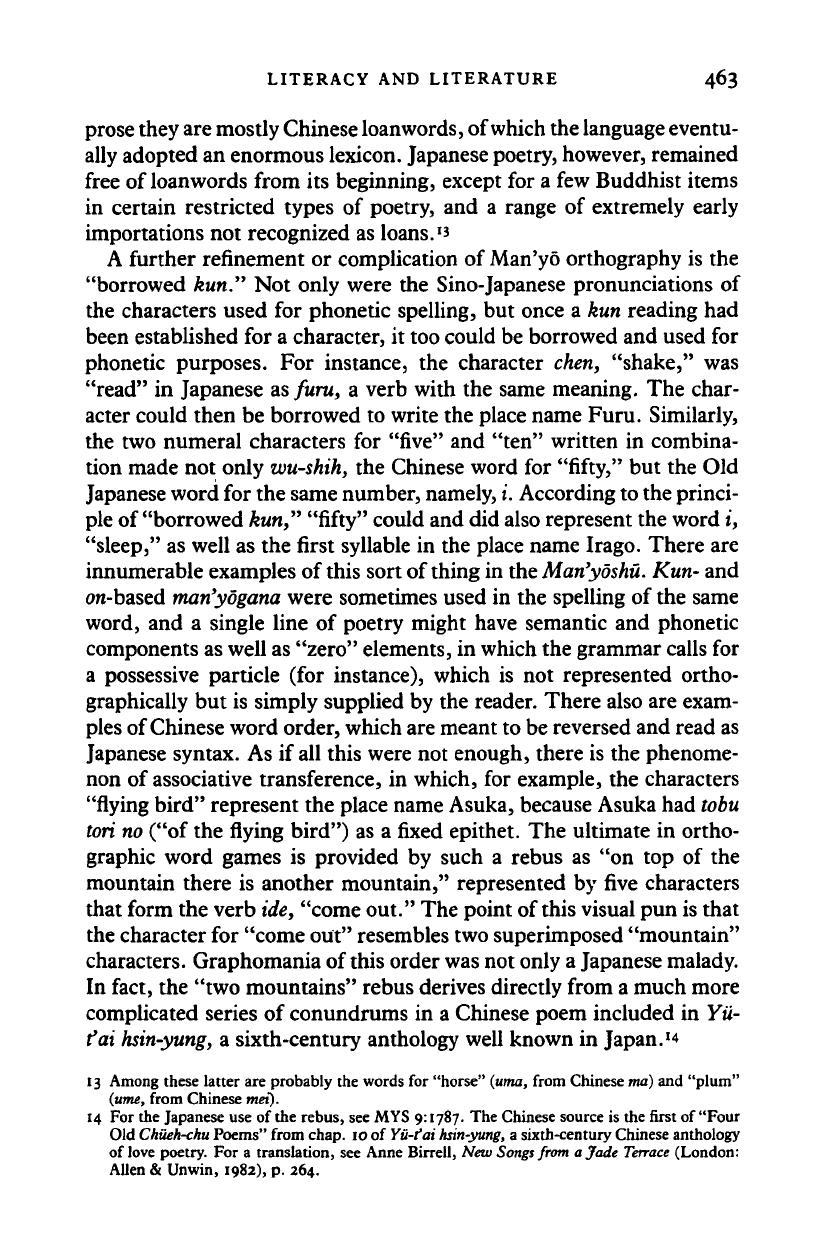
LITERACY AND LITERATURE 463
prose they
are
mostly Chinese
loanwords,
of which the language eventu-
ally adopted an enormous lexicon. Japanese poetry, however, remained
free of loanwords from its beginning, except for a few Buddhist items
in certain restricted types of poetry, and a range of extremely early
importations not recognized as loans.**
A further refinement or complication of Man'yo orthography is the
"borrowed kun." Not only were the Sino-Japanese pronunciations of
the characters used for phonetic spelling, but once a kun reading had
been established for a character, it too could be borrowed and used for
phonetic purposes. For instance, the character chen, "shake," was
"read" in Japanese
as
furu, a verb with the same meaning. The char-
acter could then be borrowed to write the place name Furu. Similarly,
the two numeral characters for "five" and "ten" written in combina-
tion made not only
wu-shih,
the Chinese word for "fifty," but the Old
Japanese word for the same number, namely,
i.
According to the princi-
ple of "borrowed kun," "fifty" could and did also represent the word i,
"sleep,"
as well as the first syllable in the place name Irago. There are
innumerable examples of
this
sort of thing in the
Man'yoshu.
Kun- and
on-based
man'yogana
were sometimes used in the spelling of the same
word, and a single line of poetry might have semantic and phonetic
components as well as "zero" elements, in which the grammar calls for
a possessive particle (for instance), which is not represented ortho-
graphically but is simply supplied by the reader. There also are exam-
ples of Chinese word order, which are meant to be reversed and read as
Japanese syntax. As if all this were not enough, there is the phenome-
non of associative transference, in which, for example, the characters
"flying bird" represent the place name Asuka, because Asuka had
tobu
tori no
("of the flying bird") as a fixed epithet. The ultimate in ortho-
graphic word games is provided by such a rebus as "on top of the
mountain there is another mountain," represented by five characters
that form the verb
ide,
"come out." The point of
this
visual pun is that
the character for "come out" resembles two superimposed "mountain"
characters. Graphomania of
this
order was not only a Japanese malady.
In fact, the "two mountains" rebus derives directly from a much more
complicated series of conundrums in a Chinese poem included in Yii-
fai
hsin-yung,
a sixth-century anthology well known in Japan.
1
-*
13 Among these latter are probably the words for "horse" (uma, from Chinese ma) and "plum"
(time, from Chinese met).
14 For the Japanese use of the rebus, see MYS 9:1787. The Chinese source is the first of "Four
Old
Chiieh-chu
Poems" from chap. 10 of Yu-tai
hsin-yung,
a sixth-century Chinese anthology
of love poetry. For a translation, see Anne Birrell, New
Songs from
a Jade
Terrace
(London:
Allen & Unwin, 1982), p. 264.
Cambridge Histories Online © Cambridge University Press, 2008
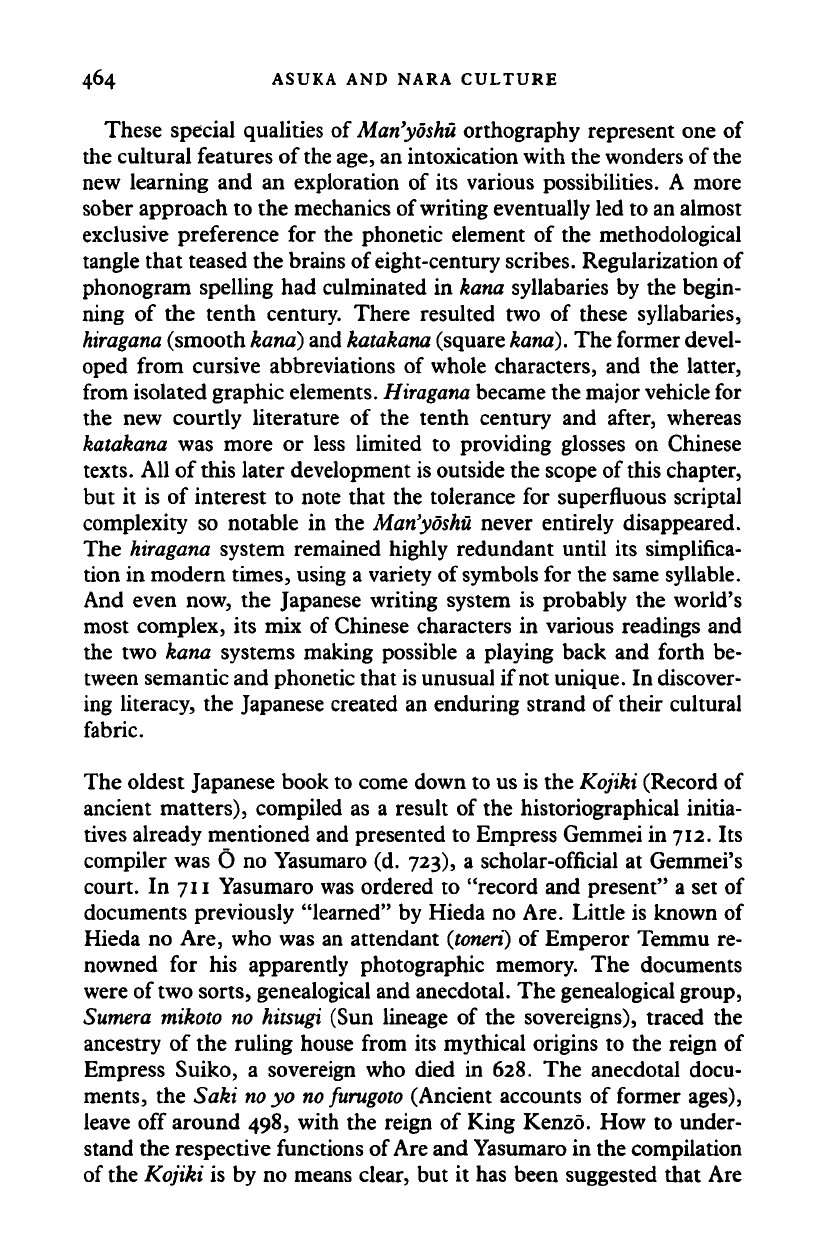
464 ASUKA AND NARA CULTURE
These special qualities of
Man'yoshu
orthography represent one of
the cultural features of the age, an intoxication with the wonders of the
new learning and an exploration of its various possibilities. A more
sober approach to the mechanics of writing eventually led to an almost
exclusive preference for the phonetic element of the methodological
tangle that teased the brains of eight-century scribes. Regularization of
phonogram spelling had culminated in kana syllabaries by the begin-
ning of the tenth century. There resulted two of these syllabaries,
hiragana
(smooth kana) and
katakana
(square
kana).
The former devel-
oped from cursive abbreviations of whole characters, and the latter,
from isolated graphic elements.
Hiragana
became the major vehicle for
the new courtly literature of the tenth century and after, whereas
katakana was more or less limited to providing glosses on Chinese
texts.
All of this later development is outside the scope of
this
chapter,
but it is of interest to note that the tolerance for superfluous scriptal
complexity so notable in the
Man'yoshu
never entirely disappeared.
The
hiragana
system remained highly redundant until its simplifica-
tion in modern times, using a variety of symbols for the same syllable.
And even now, the Japanese writing system is probably the world's
most complex, its mix of Chinese characters in various readings and
the two kana systems making possible a playing back and forth be-
tween semantic and phonetic that is unusual if not unique. In discover-
ing literacy, the Japanese created an enduring strand of their cultural
fabric.
The oldest Japanese book to come down to us is the Kojiki (Record of
ancient matters), compiled as a result of the historiographical initia-
tives already mentioned and presented to Empress Gemmei in 712. Its
compiler was O no Yasumaro (d. 723), a scholar-official at Gemmei's
court. In 711 Yasumaro was ordered to "record and present" a set of
documents previously "learned" by Hieda no Are. Little is known of
Hieda no Are, who was an attendant
(tonert)
of Emperor Temmu re-
nowned for his apparently photographic memory. The documents
were of two sorts, genealogical and anecdotal. The genealogical group,
Sumera mikoto no
hitsugi
(Sun lineage of the sovereigns), traced the
ancestry of the ruling house from its mythical origins to the reign of
Empress Suiko, a sovereign who died in 628. The anecdotal docu-
ments, the Saki
no
yo
no furugoto
(Ancient accounts of former ages),
leave off around 498, with the reign of King Kenzo. How to under-
stand the respective functions of Are and Yasumaro in the compilation
of the Kojiki is by no means clear, but it has been suggested that Are
Cambridge Histories Online © Cambridge University Press, 2008
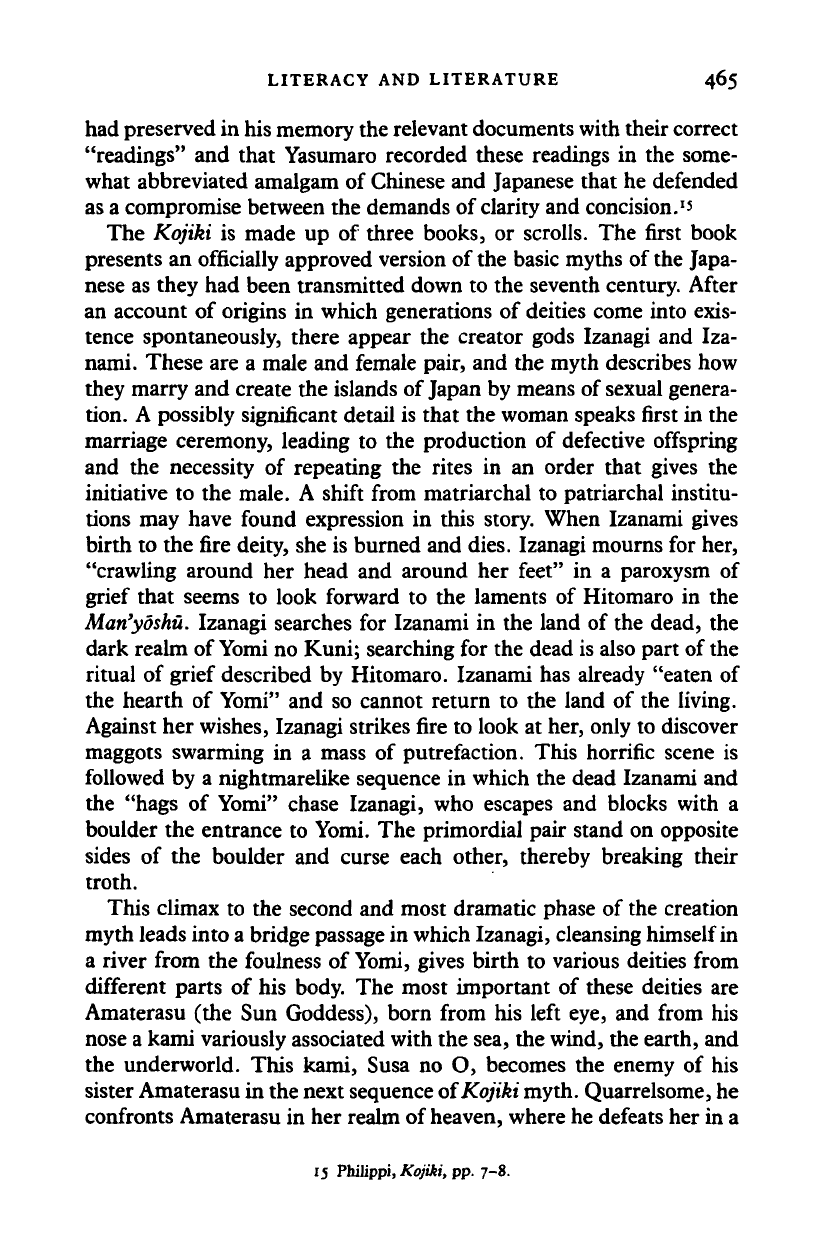
LITERACY AND LITERATURE 465
had preserved in his memory the relevant documents with their correct
"readings" and that Yasumaro recorded these readings in the some-
what abbreviated amalgam of Chinese and Japanese that he defended
as a compromise between the demands of clarity and concision. '*
The Kojiki is made up of three books, or scrolls. The first book
presents an officially approved version of the basic myths of the Japa-
nese as they had been transmitted down to the seventh century. After
an account of origins in which generations of deities come into exis-
tence spontaneously, there appear the creator gods Izanagi and Iza-
nami. These are a male and female pair, and the myth describes how
they marry and create the islands of Japan by means of sexual genera-
tion. A possibly significant detail is that the woman speaks first in the
marriage ceremony, leading to the production of defective offspring
and the necessity of repeating the rites in an order that gives the
initiative to the male. A shift from matriarchal to patriarchal institu-
tions may have found expression in this story. When Izanami gives
birth to the fire deity, she is burned and dies. Izanagi mourns for her,
"crawling around her head and around her feet" in a paroxysm of
grief that seems to look forward to the laments of Hitomaro in the
Man'yoshu. Izanagi searches for Izanami in the land of the dead, the
dark realm of
Yomi
no Kuni; searching for the dead is also part of the
ritual of grief described by Hitomaro. Izanami has already "eaten of
the hearth of Yomi" and so cannot return to the land of the living.
Against her wishes, Izanagi strikes fire to look at her, only to discover
maggots swarming in a mass of putrefaction. This horrific scene is
followed by a nightmarelike sequence in which the dead Izanami and
the "hags of Yomi" chase Izanagi, who escapes and blocks with a
boulder the entrance to Yomi. The primordial pair stand on opposite
sides of the boulder and curse each other, thereby breaking their
troth.
This climax to the second and most dramatic phase of the creation
myth leads into a bridge passage in which Izanagi, cleansing himself in
a river from the foulness of
Yomi,
gives birth to various deities from
different parts of his body. The most important of these deities are
Amaterasu (the Sun Goddess), born from his left eye, and from his
nose a kami variously associated with the sea, the wind, the earth, and
the underworld. This kami, Susa no O, becomes the enemy of his
sister Amaterasu in the next sequence of Kojiki myth. Quarrelsome, he
confronts Amaterasu in her realm of
heaven,
where he defeats her in a
15 Philippi,
Kojiki,
pp. 7-8.
Cambridge Histories Online © Cambridge University Press, 2008
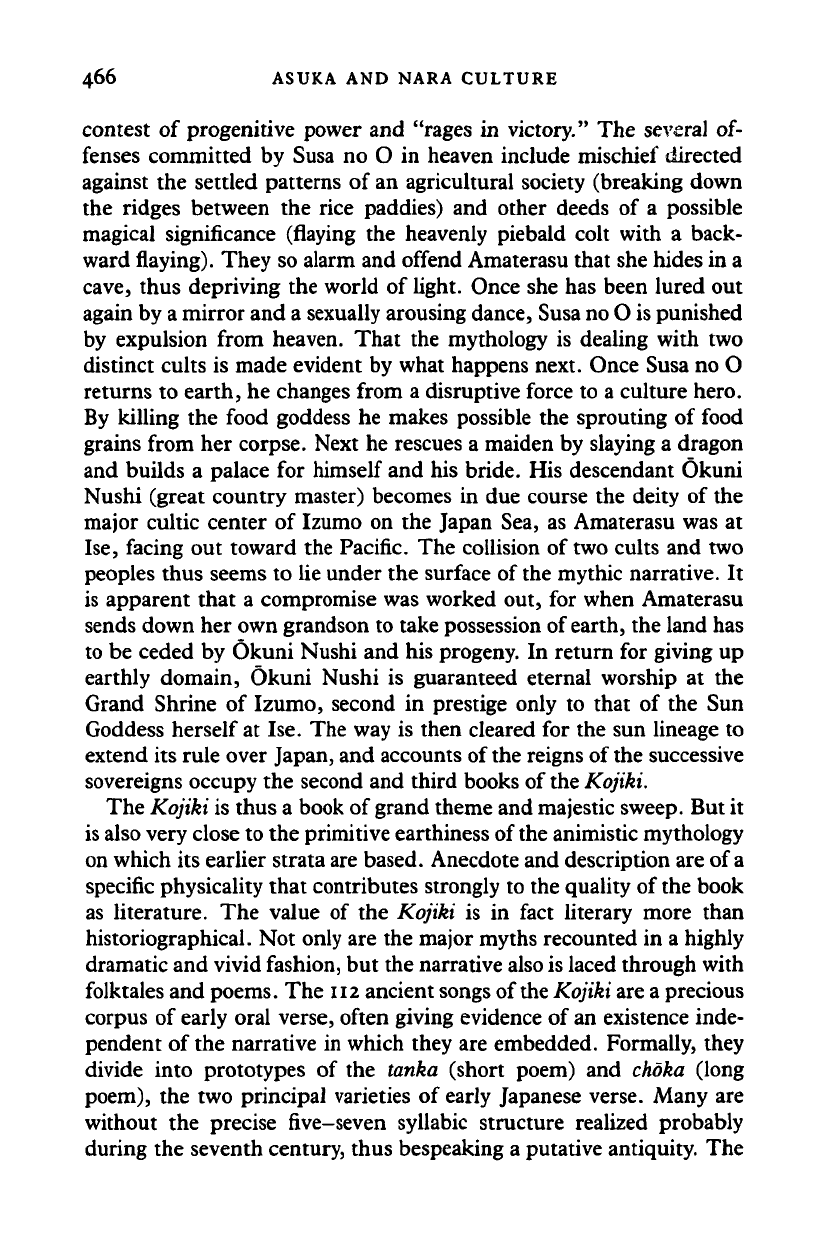
466 ASUKA AND NARA CULTURE
contest of progenitive power and "rages in victory." The several of-
fenses committed by Susa no O in heaven include mischief directed
against the settled patterns of an agricultural society (breaking down
the ridges between the rice paddies) and other deeds of a possible
magical significance (flaying the heavenly piebald colt with a back-
ward flaying). They so alarm and offend Amaterasu that she hides in a
cave,
thus depriving the world of light. Once she has been lured out
again by a mirror and a sexually arousing dance, Susa no O is punished
by expulsion from heaven. That the mythology is dealing with two
distinct cults is made evident by what happens next. Once Susa no O
returns to earth, he changes from a disruptive force to a culture hero.
By killing the food goddess he makes possible the sprouting of food
grains from her corpse. Next he rescues a maiden by slaying a dragon
and builds a palace for himself and his bride. His descendant Okuni
Nushi (great country master) becomes in due course the deity of the
major cultic center of Izumo on the Japan Sea, as Amaterasu was at
Ise,
facing out toward the Pacific. The collision of two cults and two
peoples thus seems to lie under the surface of the mythic narrative. It
is apparent that a compromise was worked out, for when Amaterasu
sends down her own grandson to take possession of
earth,
the land has
to be ceded by Okuni Nushi and his progeny. In return for giving up
earthly domain, Okuni Nushi is guaranteed eternal worship at the
Grand Shrine of Izumo, second in prestige only to that of the Sun
Goddess herself at Ise. The way is then cleared for the sun lineage to
extend its rule over Japan, and accounts of the reigns of the successive
sovereigns occupy the second and third books of the Kojiki.
The Kojiki is thus a book of grand theme and majestic sweep. But it
is also very close to the primitive earthiness of
the
animistic mythology
on which its earlier strata are based. Anecdote and description are of
a
specific physicality that contributes strongly to the quality of the book
as literature. The value of the Kojiki is in fact literary more than
historiographical. Not only are the major myths recounted in a highly
dramatic and vivid fashion, but the narrative also is laced through with
folktales and poems. The
112
ancient songs of the Kojiki are a precious
corpus of early oral verse, often giving evidence of an existence inde-
pendent of the narrative in which they are embedded. Formally, they
divide into prototypes of the tanka (short poem) and choka (long
poem),
the two principal varieties of early Japanese verse. Many are
without the precise five-seven syllabic structure realized probably
during the seventh century, thus bespeaking a putative antiquity. The
Cambridge Histories Online © Cambridge University Press, 2008
